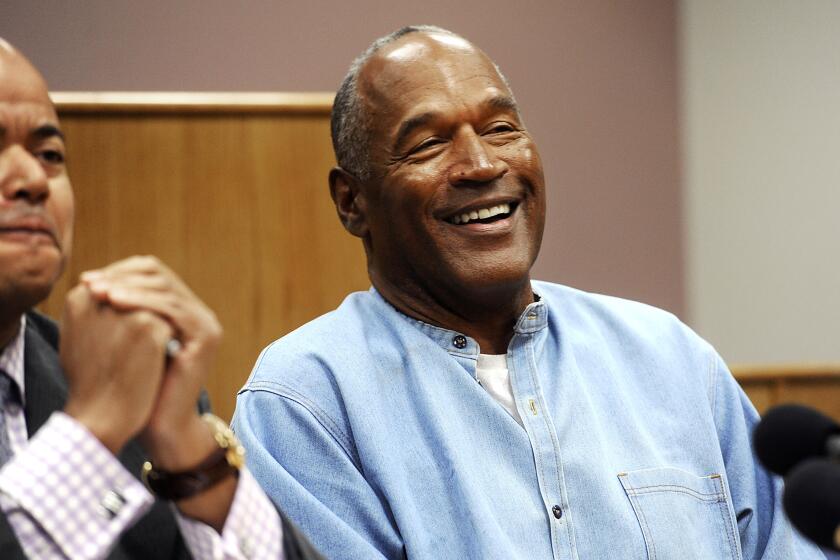Artist aims to transform billboards into hanging gardens
Garages buckled, highways collapsed. Swift but violent, the 1994 Northridge earthquake damaged buildings for miles around.
But Los Angeles artist Stephen Glassman noticed one type of structure held strong: Billboards.
The memory stayed with Glassman over the years. Then he had a thought. Why not entirely re-imagine those everyday pillars of steel?
“Urban Air,” his latest project, aims to transform billboards into suspended bamboo gardens and create “an open space” in the city skyline.
“There is an advertising infrastructure that goes through this city that is strong and robust and at this moment only dedicated toward selling you things, and it could be much more,” said Glassman, who earned recognition in the 1990s for his free-form bamboo installations. “It could be both a symbol and an instrument for generating a green future.”
The idea comes with a long list of challenges: retrofitting a billboard to house a living thing that needs water, for starters. The proper permits also need to be obtained from a city that has a history of billboard battles.
And there’s the cost. The estimated budget for the first billboard is $100,000, a figure Glassman posted on Kickstarter, a public funding platform. Donations had reached $34,000 in a month. Glassman and his team of pro bono engineers, draftsmen and innovation advisors have until Dec. 11 to raise the entire amount. Or forfeit it all.
Still, the project’s unique blend of environmentalism, art and public access has struck a chord with the hundreds who have donated so far, many of whom hope its success would prompt similar efforts in their hometowns. Supporting Urban Air, said Edward Chiang of Taipei, Taiwan, who sent in $10, was “like buying a dream.”
And some Angelenos say transforming something so intrinsic to this sprawling city’s infrastructure feels authentic and homegrown.
“It’s an art project that’s really L.A.,” said Giovanni Solis, 23, who works in video production and photography and who chipped in $25. “He’s using what we have to make the city a little better. It’s an interesting take on transforming dead spaces to make them more sustainable and eco-conscious.”
If the funding comes through, Glassman said he would like to have the first arrangement of bamboo — chosen for its ability to attain great height with minimal root space — up by February. Although no location has been pinned down, he wants a billboard near a major Los Angeles freeway or a busy thoroughfare — the more chaotic, the better for stark contrast. And more opportunity to give drivers a sense of calm.
Summit Media, one of the largest billboard companies in the city, has already committed to donating at least one of its billboards.
“There is irony inherent in the project, which is fine by me. That kind of keeps things exciting,” said Alex Kouba, the company’s founder. “It’s also a testament to the strength of the medium. I guess the irony can cut both ways.”
Kouba said he plans to wait until after funds are raised to speak to the city about the project’s feasibility. “Hopefully the city will be flexible,” he said.
Making the idea work could be tricky. Russell Fortmeyer, an engineer with Arup who has been assisting on the project, said they’ve even talked of mining moisture from the air to water the bamboo. Then there’s the question of how much the installation would weigh — and whether the billboard could support the weight. They want to avoid restructuring of the billboard frame, which could be costly.
David Lara, spokesman for the Los Angeles Department of Building and Safety, said his department would need to consult with the city attorney’s office before approving a permit for such a project. Sign-offs from fire and planning authorities might also be necessary, Lara said.
Longtime billboard opponent Dennis Hathaway said he would rather see a bamboo garden than advertising. “But I’m not sure how long it would last. At some point that billboard is going to be a McDonald’s ad again.”
Glassman and his team say they envision Urban Air as a global concept with a future as resilient as the billboards themselves. They’d like to create a blueprint that could be easily re-created but reinterpreted in hundreds of ways: different plants, different sizes and shapes of billboards. They said they hope the idea draws backing from philanthropists or such initiatives as C40, a network of cities devoted to addressing climate change.
“Wouldn’t it be great if a bunch of people see it as their board, their place, their piece of art?” said Dan Burrier, chief executive of Common, an organization that works with socially conscious startups, and Urban Air’s marketing and social media advisor. “Then you start a different conversation about what relationships people have to their city.... Are they victims of it? Or can they be contributors and creators?”
More to Read
Start your day right
Sign up for Essential California for news, features and recommendations from the L.A. Times and beyond in your inbox six days a week.
You may occasionally receive promotional content from the Los Angeles Times.







